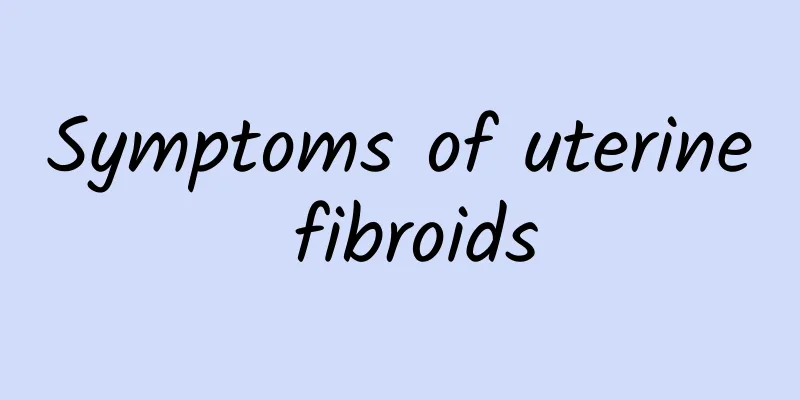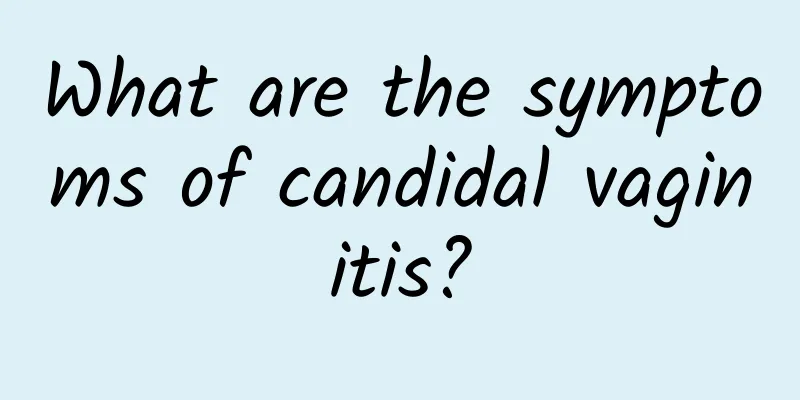Symptoms of uterine fibroids

|
I believe that everyone is no longer unfamiliar with the disease of uterine fibroids. Although it is a benign tumor, it has caused great trouble to the life and work of patients. Let's take a look at the symptoms of uterine fibroids to help everyone find and treat them early. Symptoms of uterine fibroids are divided into the following categories: (1) Uterine bleeding: Uterine bleeding is the most common symptom of uterine fibroids. Clinically, it can be manifested as menorrhagia, cyclical bleeding, increased menstrual volume, and often accompanied by prolonged menstruation. This type of bleeding is the most common; frequent menstruation, shortened menstrual cycle, increased menstrual volume; irregular bleeding, loss of normal menstrual periodicity, long duration, sometimes more, sometimes less, and continuous bleeding, which is more common in submucosal fibroids. Uterine bleeding is more common in submucosal fibroids and intermuscular fibroids, and subserosal fibroids rarely cause uterine bleeding. According to literature reports, the incidence of uterine bleeding in submucosal fibroids, intermuscular fibroids, and subserosal fibroids is 89.5%-100%, 74%-77.7%, and 33.3%-36%, respectively. There are many explanations for the cause of uterine bleeding. (2) Abdominal mass: The uterus is located deep in the pelvic cavity, and the mass cannot be felt in the abdomen when the fibroids first appear. When uterine fibroids gradually increase in size, the uterus exceeds the size of a 3-month pregnancy, or the subserosal fibroids located at the bottom of the uterus are easier to touch from the abdomen. The mass is located in the middle of the lower abdomen, solid, movable but not very mobile, without tenderness, and grows slowly. If the patient's abdominal wall is thick, the uterus is enlarged, or it exceeds the pelvic cavity and even reaches the size of a 4-5-month pregnancy, it is still difficult for the patient to find it by herself. Therefore, few patients with uterine fibroids seek medical treatment due to abdominal masses. Huge submucosal fibroids prolapse outside the vagina, and patients may seek medical treatment due to prolapse of the vulva. Tumors are often accompanied by infection and necrosis, and such patients have been rare in recent years. (3) Vaginal discharge: Uterine submucosal fibroids or cervical submucosal fibroids can cause increased vaginal discharge. Once the tumor is infected, there may be a large amount of purulent vaginal discharge. If there is ulceration, necrosis, or bleeding, there may be bloody or purulent vaginal discharge with a foul odor. (4) Compression symptoms: Uterine fibroids can cause compression symptoms of surrounding organs. Uterine anterior wall fibroids close to the bladder can cause bladder irritation symptoms, manifested as frequent urination and urgency; when cervical fibroids grow forward to a considerable size, they can also cause bladder compression and lead to upper pubic discomfort, frequent urination, urinary retention or overflow incontinence; giant cervical anterior lip fibroids filling the vagina and compressing the urethra can cause dysuria and even urinary retention. Patients may seek medical attention due to urinary system symptoms. Uterine posterior wall fibroids, especially giant fibroids in the isthmus or posterior lip of the cervix filling the vagina, compress the rectum backwards, and can cause posterior pelvic swelling and constipation. Broad ligament fibroids or giant cervical fibroids develop laterally and embed into the pelvic cavity, compressing the ureter and causing obstruction of the upper urinary tract, resulting in ureteral dilatation and even hydronephrosis. It is rare for lower limb edema to occur due to obstruction of pelvic lymph and venous blood flow caused by fibroid compression. (5) Pain: Generally, uterine fibroids do not cause pain symptoms. If pain symptoms occur, it is mostly caused by pathological changes in the fibroids themselves or combined with other pelvic diseases. ① Pathological changes of uterine fibroids: Red degeneration of uterine fibroids is common during pregnancy, manifested as acute abdominal pain in the lower abdomen, accompanied by vomiting, fever and local tenderness of the tumor; subserosal uterine fibroid pedicle torsion, or giant subserosal uterine fibroids at the bottom of the uterus can cause uterine torsion in some cases, which can cause acute abdominal pain; submucosal uterine fibroids can also cause abdominal pain when they are discharged from the uterine cavity, but generally the discharge process is slow and gradual, and the cervix is soft. Due to the stimulation of fibroids, uterine contraction may cause paroxysmal lower abdominal discomfort, which rarely causes acute abdominal pain; submucosal uterine fibroids infected and necrotized and caused pelvic inflammatory disease can cause abdominal pain, but it is rare; there have been 5 reports in the literature that women with uterine fibroids had focal bleeding in the fibroids due to taking contraceptives, which caused severe abdominal pain. Fibroids have multifocal bleeding after histological examination, which is called fibroid stroke. ② Combined with other pelvic diseases: The most common are adenomyosis or endometriosis. The pain is characteristic, which is cyclical, progressive and gradually worsening dysmenorrhea, often accompanied by anal prolapse and dyspareunia rather than acute abdominal pain. (6) Infertility and miscarriage: Most patients with uterine fibroids can conceive and carry their pregnancies to term. However, some women of childbearing age are infertile and cannot find other reasons other than fibroids. They become pregnant after myomectomy, indicating that infertility is related to fibroids. The location, size, and number of fibroids may have a certain impact on conception and pregnancy outcomes. Cervical fibroids may affect the entry of sperm into the uterine cavity; submucosal fibroids may hinder the implantation of fertilized eggs; giant primary uterine fibroids deform the uterine cavity, especially the interstitial part of the fallopian tube is squeezed by fibroids and blocked, hindering the passage of sperm; some people believe that uterine fibroids cause congestion and dilation of the muscle wall and endometrial veins, especially the endometrium, which results in an intrauterine environment that is not conducive to the implantation of fertilized eggs or insufficient blood supply to embryonic development, leading to miscarriage. (7) Anemia: The main symptom of uterine fibroids is uterine bleeding. Long-term excessive menstruation or irregular bleeding can lead to hemorrhagic anemia. Clinically, there are different degrees of anemia symptoms. Severe anemia is more common in submucosal fibroids. Severe anemia, especially for a long time, can cause myocardial nutritional disorders. (8) Polycythemia: Polycythemia with uterine fibroids is rare. Most patients are asymptomatic. The main basis for diagnosis is increased hemoglobin and red blood cell count. No other cause of polycythemia can be found except uterine fibroids. After tumor resection, hemoglobin and red blood cells return to normal. In 1964, Wu Baozhen reported a case of uterine fibroids combined with polycythemia. The patient was 35 years old and her abdomen was swollen like a full-term pregnancy. Laparotomy revealed a huge lobed solid tumor with tortuous and dilated surface veins. The tumor originated from the left posterior wall of the uterus. The bilateral adnexa were normal. Subtotal hysterectomy and bilateral adnexectomy were performed. (9) Hypoglycemia: Hypoglycemia associated with uterine fibroids is also rare. The main symptoms are low fasting blood sugar, loss of consciousness and even shock. The symptoms can completely disappear after glucose injection. Hypoglycemia symptoms will completely disappear after tumor resection. Uterine fibroids: http://www..com.cn/fuke/zgjl/ |
<<: Treatment of uterine fibroids
>>: The harm of uterine fibroids
Recommend
Why does vaginal bleeding still occur after years of amenorrhea?
Why does vaginal bleeding still occur after years...
What are the symptoms of cervical erosion in women? Pay attention to these severe symptoms of cervical erosion
Many women are not particularly familiar with the...
Two prescriptions for endometriosis
Two prescriptions for endometriosis Endometriosis...
Why does cervical erosion recur repeatedly?
Cervical erosion is a common gynecological diseas...
What are the dangers of having uterine effusion?
Do you know the dangers of uterine effusion? Uter...
Women can lose weight more effectively by mastering physiological changes
May is the season of thanksgiving. Children shoul...
What should a young girl do if she suffers from uterine fibroids? Who are the high-risk groups for uterine fibroids?
Many people think that uterine fibroids belong to...
Let's take a look at the precautions after winter abortion
The impact of abortion on women cannot be ignored...
Is adnexitis serious?
Is adnexitis serious? Women's appendages main...
Morning running VS night running! Which is best for weight loss?
Many people choose to jog for health reasons or t...
How is cervicitis diagnosed?
Cervicitis is one of the common diseases among wo...
Things you need to know about early precautions for adnexitis
What are the early precautions for adnexitis? Adn...
What is locked-in syndrome called in Chinese medicine?
Locked-in syndrome is called "paralysis"...
We should pay attention to the nursing work of patients with cervical erosion
Cervical erosion is a very serious female disease...
What is the reason for the light color of the first day of menstruation?
What is the reason for the light color of the fir...









